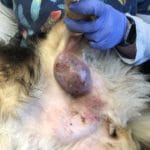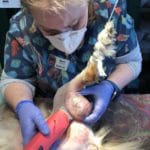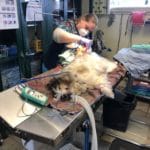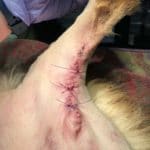Only a month before bringing another animal in? He might be unsettled. Get back to your daily training and he’ll come back to you as his primary person.
My sisters dog has been sick. She wanted to bring him here to play with my dogs and I told her I’d rather not until he saw the vet, he had an apt. Can dogs spread germs like people do. Now that I know they can get corona I was concerned.
Comments
Hi there. My dog Ruby had sudden onset Mast Cell Tumors present about 3 weeks ago. She’s an energetic 4 year old pit/great dane mix (I know because I spent a billion dollars on a DNA kit). I noticed about 7 subcutaneous lumps on her left side while she was outside playing. They felt like little oblong marbles under her skin. Our vet is an hour away. We had moved a few months back and kept our vet because we love him so much. We still see him for routine care. There is a vet very close to our home and I have read good reviews and have had email conversation previously when I was deciding whether or not to switch vets. I was concerned Ruby would have cancer, I just felt it, and didn’t want her to have to make several long trips to our vet if she were to require surgery, etc. So I decided to take her to the new close to home vet. As it is Covid-19 season, I did not get to go inside the vet’s office with her. They aspirated one of the lumps and were concerned. She was scheduled for surgery in the following week. I talked to my other vet about this, and he was not pleased to hear they aspirated her, because he was worried that the histamines from the tumor would cause it to spread. I was alarmed and researched Dr. Google for 2 days. It seemed to me after my research that the aspiration was standard course of care. Ruby had her surgery and had 2 large masses removed. They could not take all of them because there would have been too many incision sites. Directions for care included keeping her inactive for 10-14 days, not an easy dear with an anxious 65 lb lap dog. On day 7 of recovery, I noticed a fluid buildup around the incision site. Back to Dr. Google, I decided she had a seroma. I called the vet the next morning and we took her over and my suspicion was confirmed. They told us to call if it got worse. We still haven’t received the pathology back on the two masses that were removed. This morning I decided I needed to do more research, as two new masses have cropped up (the tumors, not seroma). Ruby is in good spirits and just wants to play and run with our other dogs. She’s mad at me, I’m sure of it, for making her lay around all day. Is it normal to have a seroma after surgery? Why do these tumors pop up all of a sudden?
So, we rescued a dog about a month ago, and since then me and him have had a really strong bond until recently. Nearly 2 weeks ago we found a baby kitten abandon and we took him home, so I’ve been busy taking care of him aswell. My dog seems to be more distant towards me and hanging out with other household members instead. I think he may be upset, will this go on forever or will he get over it? I miss my big boy by my side all the time
Comments
This isn’t anything major, I’m just wondering why, when I’m busy or on my phone, my dog just stares at me with the saddest eyes the whole time? We rescued him a little over a month ago, he had been shot in the head with a BB gun and we nursed him back to health. He’s the only one he does this to
Comments
I need help finding services for my dog I feel it’s an emergency to give you a little bit of background I’ve had our dog for about 2 years now I hadn’t looked at by a family friend a year ago cuz I noticed a bump on her lower back they said it would be fine as long as it doesn’t rupture well today’s the day it did I don’t have the finances to get her help I’m scared that it can take her from us or make her very sick as selfish as I want to be in this moment not to surrender my pet I would if I had to so I’m asking is there any resources out there that can help me please help her
Comments
I am having a german shepherd dog and she rarely eats something nowadays and she is having muddy eyes and mouth foam
Comments
I am in obx and I have been looking for help with my dog . I have saw your blog and your videos on you tube and wanted to reach out to you. My dog might have disc disease . She is in a hospital on another island down here . Actually it is my grandsons dog, he lives with me alone and this has been his best friend for 4 years . He is 11 and we adopted her . She woke up Monday and her back legs were shaky and then we took her to hospital and she has been there ever since . They have treated her with meds incase it was a bacteria or tick disease but she still can’t use her back legs. She still can’t stand . She is still in vets resting and getting great care. We don’t have much money so we can’t get her an mri but I grew up near jarretsville(went to John Carroll high) and when I saw your blog and video I thought maybe you could give us some advice. Can we email you? My email is Marygrace58@aol.com . I thank you so much! The vet here is so awesome and still gives us hope! but they are saying I might want to consider putting her down. Which I understand but I saw your videos and thought I might reach out. My grandson wants to bring her home but she can’t walk and use bathroom. Was hoping you could give us some help or advice. I just called up to your office because I was hoping to talk to you. The lady that answered the phone said this was the best way to contact you. My phone is 804 814 5068. I do not want to put the dog down. I would like to try and would like some ideas from you. Thank you for your time. Marygrace and AJ
Comments
We rescued our almost 2 year old dog in early January. She was spade in November I believe. In late February she was diagnosed with a UTI and has seemed to have issues ever since. She was given medicine for her UTI and as soon as she finished she seemed to have some more dribbling at times, and straining and not a large production of urine. We took her to the vet and they said there was some formation of crystals, her PH was high, and they recommended notto do a certain kind of testing (I can’t remember what) because she just came off antibiotics and said it wouldn’t yield true results. They said we could do a blood test and X-ray, but I wasn’t sure it was necessary. A few days later she had what I believe they called large intestine diarrhea and needed medication for that. She just finished the medication and probiotic for that this week and now she is having some dribbling or puddling issues. I noticed it yesterday, but I thought my son just scared her with his toy. Today, it was after coming in from a walk. She was laying down and peed a small puddle. She has been drinking plenty and goes to the bathroom and produces a normal amount of urine, she doesn’t seem to strain at all. Not sure if I should call the vet and what kind of tests she should get moving forward. It is getting very expensive and I can’t keep spending almost $200 for each vet visit.
Comments
My dog’s stomach got hard 4 days ago. That night, she vomited what she ate. Since then she rarely ate. Sometimes we can coax her with a piece of chicken but only rarely. She drinks a lot of water. On the 3rd day, she barely ate. Now she has some discharge on her private parts. It is a cloudy white. She keeps licking it and could not sleep. She keeps pacing too. She would walk in circles.
She always looks tired but likes going for a walk. But when at home, she doesn’t even stand up.
We are not able to go to a vet’s office right now because of financial issues and the lockdown. What can I do?





















Hello,
All infectious diseases have the potential to affect and infect others. But this might not be caused by an infection so it is hard to know if he is infectious. I think it is best to play it safe and keep them apart. Start with a vet visit. All sick beings (people and pets) should always be kept away from each other when they are sick.